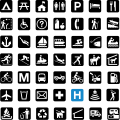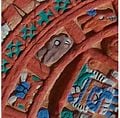Pictogram
 Writing systems |
|---|
| History |
| Types |
| Alphabet |
| Abjad |
| Abugida |
| Syllabary |
| Logogram |
| Related |
| Pictogram |
| Ideogram |
A pictogram (also spelled pictogramme) or pictograph is a symbol representing a concept, object, activity, place or event by illustration. Pictography is a form of writing in which ideas are transmitted through drawing. It is a basis of cuneiform and, to some extent, hieroglyphic writing, which uses drawings also as phonetic letters or determinative rhymes.
Early written symbols were based on pictograms (pictures which resemble what they signify) and ideograms (symbols which represent ideas). They were used by the ancient Chinese culture since around 5000 B.C.E. and began to develop into logographic writing systems around 2000 B.C.E. Pictograms are still in use as the main medium of written communication in some non-literate cultures in Africa, The Americas, and Oceania. Pictograms are often used as simple symbols by most contemporary cultures.
Earliest use
The earliest pictograms were in use in Mesopotamia and predated the famous Sumerian cuneiforms (the oldest of which date to around 3400 B.C.E.). As early as 9000 B.C.E. tokens marked with simple pictures began to be used to label basic farm produce. Around 6000 B.C.E., with the rise of cities and spread of basic craftmanship, more complex pictographic tokens were devised to label manufactured goods. Eventually the tokens were replaced by clay tablets on which symbols were drawn with a blunt reed called a stylus. The impressions left by the stylus were wedge shaped, thus giving rise to the name cuneiform; wedge-writing.[1]
Though written Chinese is often thought of consisting of pictograms, less than 4% of all characters ever created have their direct origins in pictograms. The letters of the Roman alphabet, however, do have their origins in pictograms. For example, the letter A represented the head of an ox, and if it is turned upside down, a bovine head with horns can be seen.
Modern use
Template:Cleanup Pictograms were extensively used on a London Suburban map of the London & North Eastern Railway map in 1937, and remain in common use today, serving as signs or instructions. Because of their graphical nature and fairly realistic style, they are widely used to indicate public toilets, or places such as airports and train stations. However, even these symbols are highly culture-specific. For example, in some cultures men commonly wear dress-like clothing, so even restroom signage is not universal.
A standard set of pictograms was defined in the international standard ISO 7001: Public Information Symbols. Another common set of pictograms are the laundry symbols used on clothing tags and chemical hazard labels. Pictography hinders search-engine capability, requiring symbol searching, while text-based writing also facilitates spoken words, even new words by use of pronunciation rules, and text enables sorting information alphabetically.
Pictographic writing as a modernist poetic technique is credited to Ezra Pound though French surrealists accurately credit the Pacific Northwest American Indians of Alaska who introduced writing, via totem poles, to North America (Reed 2003, p. xix).
Pictograms can also be seen in various crop circles.
Sample National Park Service pictographs
Pictograph from 1510 telling a story of coming of missionaries to Hispaniola
Water, rabbit, deer pictograms on a replica of an Aztec Stone of the Sun
See also
- Chinese character
- DOT pictograms
- Emoticon
- Icon (computing)
- Ideogram
- Writing system
- Yakima Indian Painted Rocks
- Asemic Writing
ReferencesISBN links support NWE through referral fees
- Reed, Ishmael (2003). From Totems to Hip-Hop: A Multicultural Anthology of Poetry Across the Americas, 1900-2002, Ishmael Reed, ed. ISBN 1-56025-458-0.
External links
| |||||||||||
Credits
New World Encyclopedia writers and editors rewrote and completed the Wikipedia article in accordance with New World Encyclopedia standards. This article abides by terms of the Creative Commons CC-by-sa 3.0 License (CC-by-sa), which may be used and disseminated with proper attribution. Credit is due under the terms of this license that can reference both the New World Encyclopedia contributors and the selfless volunteer contributors of the Wikimedia Foundation. To cite this article click here for a list of acceptable citing formats.The history of earlier contributions by wikipedians is accessible to researchers here:
The history of this article since it was imported to New World Encyclopedia:
Note: Some restrictions may apply to use of individual images which are separately licensed.






